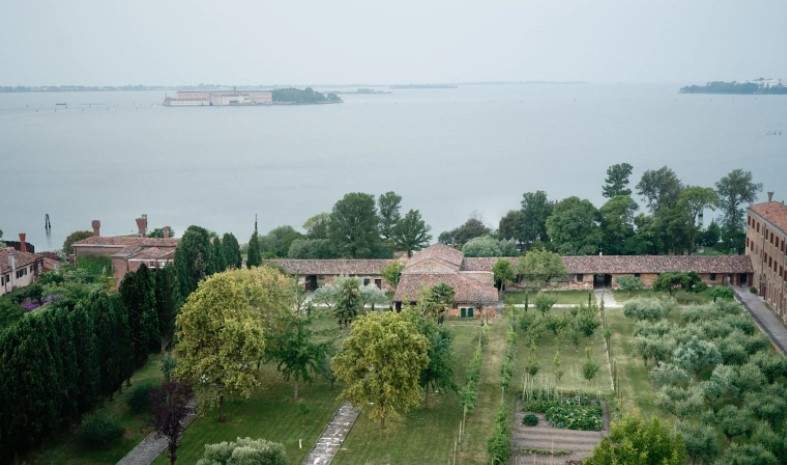Venice, the Garden Garden Garden of the Church of the Most Holy Redeemer will be restored and open to the public
On the occasion of the XXVII Venice Seminar organized by the Italian Embassy in London, the new project of Venice Gardens Foundation, entitled In Venetia Hortus Redemptoris, aimed at the restoration, conservation, management and opening to the public of the Garden Compendium - the Kitchen Garden, the Meditation Chapels, the Ancient Workshops, the Greenhouse and the Apiary - of the Convent of the Palladian Church of the Most Holy Redeemer was presented. A major City Project of international significance that gives these spaces a significant reference role, shared with the Order of Friars Minor Capuchin and the Holy See.
Built by the Serenissima and Pope Gregory XIII as a symbol of gratitude and rebirth following the plague of 1575-1577, the Redentore Complex, which stretches for about a hectare from the Giudecca Canal to the Lagoon, is significantly marked by the “acqua granda” of November 2019, an exceptional tide that, reaching 187 centimeters, submerged and devastated the city of Venice. In order to prevent the traces of such an important landscape, cultural and religious testimony from being lost, in 2021 the Monumental Compendium was entrusted to Venice Gardens Foundation by the Provincial Curia of the Capuchin Friars Minor, with the authorization of the Holy See and the Soprintendenza Archeologia Belle Arti e Paesaggio, in order to allow the recovery of the site and its subsequent reopening, with free admission to Venetians, scheduled for 2024 when the work is completed.
Chaired by Adele Re Rebaudengo, Venice Gardens Foundation has been promoting its commitment since 2014 in the restoration and conservation of parks, gardens and properties of historical and cultural interest, implementing projects aimed at the protection of botanical and artistic heritage.
In keeping with the spirit of high patronage, Venice Gardens Foundation now undertakes a new challenge, namely the rebirth of the Compendium of the Redeemer, which has never been open to the public, through a long-lasting design that, in full respect of Capuchin values, leads back to the important tradition of convent gardens and orchards, their richness and capacity for experimentation, but at the same time looks to the future with conscious and responsible commitment.
“It is an honor for Venice Gardens Foundation to be able to help pass on an Asset of such high historical, symbolic and spiritual value through its restoration and preservation over time,” said Adele Re Rebaudengo, President of Venice Gardens Foundation. “A project made possible thanks both to the affinities between the Capuchin charism and the Foundation’s mission and to the fruitful discussion with the Friars of the Convent, which led us, after two years, to start the work site today, January 30. A journey that has involved many professionals, institutions and generous patrons who enthusiastically participate in this project of ours, sharing its vision and principles: the value of restoration, respect and protection of nature in harmonious accord. A project attentive to the past, but also looking to the future with responsible commitment, faithful to the sense of responsibility, sustainability, self-sufficiency and the recognition of the founding role that these places play in a social and community context through their opening that will take place in respect of the spirit of the place.”
Key principles of the project are sustainability and self-sufficiency. The botanical restorationhas been entrusted to Paolo Pejrone, an internationally renowned gardener and landscape architect, a student of Russell Page and Roberto Burle Marx, author, among many other works, of the restoration of the Orto di Santa Croce in Gerusalemme in Rome and, on behalf of the Foundation, of the Giardini Reali di Venezia in San Marco. The architectural restoration project is by Alessandra Raso, an architect engaged in restorations of important historic-artistic complexes and projects for cultural institutions, including the Venice Biennale and the Milan Triennale. The botanical restoration has received European Union NextGenerationEU funding of 2 million euros (PNRR Ministry of Culture Restoration and enhancement of historic parks and gardens) and sees more than 2,500 trees and plants planned to be planted in architect Pejrone’s project.
Visitors will be able to walk among the olive trees, the orchard, the cypress trees, the water lily pool (a tribute to the fascination with the Orient that has always animated the Serenissima), the 400 meters of chestnut wood pergolas, handed down in Venetian gardens and covered with grape plants, roses, wisteria and bignonias, in the garden of pittosporum and roses overlooking the Lagoon, in the ancient meditation chapel and in the library next to the refreshment room. Great attention will be paid to bee welfare, with the presence of beehives and the conduct of honey extraction activities on site.
All the places restored by the Foundation are then directly cared for and preserved by the Foundation with its gardeners through specific programs, a synthesis of ancient knowledge and new techniques. On the roster of the International Private Committees for the Preservation of Venice and registered in the Ministry’s National Register of Research, Venice Gardens Foundation is also engaged in the development and application of studies aimed at innovation and sustainable and responsible management of landscape assets and related training paths.
The Foundation also collaborates with researchers and artists in the creation of works closely related to the essence and life of gardens and supports, through a system of international cooperation, the publication and transmission of texts related to garden culture.
Image: Redentore Venice, Garden Garden. Photo by Carlo Soffietti
 |
| Venice, the Garden Garden Garden of the Church of the Most Holy Redeemer will be restored and open to the public |
Warning: the translation into English of the original Italian article was created using automatic tools. We undertake to review all articles, but we do not guarantee the total absence of inaccuracies in the translation due to the program. You can find the original by clicking on the ITA button. If you find any mistake,please contact us.



























